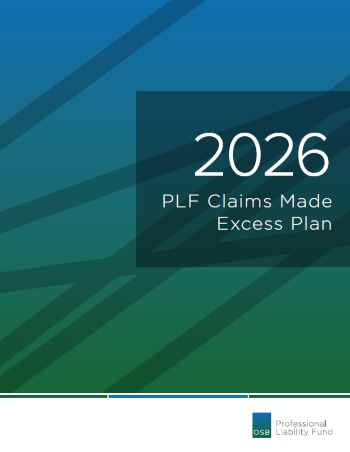Do I Need Excess Coverage?
What is Excess Coverage?
Excess coverage is professional liability coverage that provides coverage limits above, or in excess of, the statutorily required coverage limits of $300,000. Since it is not mandatory, excess coverage is underwritten – that is, law firms must submit an application for review to obtain a quote for coverage. Unlike the mandatory PLF coverage, which is individual to each covered party, excess coverage is purchased to cover law firms (including sole practitioner firms); the cost can vary depending on a variety of factors. You can obtain excess coverage from the PLF or from insurers in the commercial market.
required coverage limits of $300,000. Since it is not mandatory, excess coverage is underwritten – that is, law firms must submit an application for review to obtain a quote for coverage. Unlike the mandatory PLF coverage, which is individual to each covered party, excess coverage is purchased to cover law firms (including sole practitioner firms); the cost can vary depending on a variety of factors. You can obtain excess coverage from the PLF or from insurers in the commercial market.
Does My Firm Need Excess Coverage?
Likely, yes. While the $300,000 primary limits have remained the same for nearly thirty years, the cost of claims has escalated over that period and so has the frequency of claims in excess of the mandatory limits. Claims have become more complex, and the value of legal matters has increased. Certain areas of law now present a much higher risk for excess claims.
In addition to evaluating the risk exposure of your firm’s legal work, consider whether your personal assets may be at risk if you have a large claim. Many practitioners feel that the mandatory $300,000 does not afford enough protection.
When deciding whether excess coverage is appropriate for your firm, ask yourself these questions: Do your current malpractice coverage limits match the risk of exposure in your law practice? Will your personal assets be protected if you have an excess claim? If your answer to either of those questions is “no,” “maybe,” or “I’m not sure,” make it a priority to secure excess coverage for your firm. PLF Excess staff can help you assess your firm’s risk exposure and guide you through the process of applying for PLF Excess Coverage.
Available PLF Excess Coverage
The PLF offers excess coverage to Oregon law firms on an optional underwritten basis. Limits of coverage are available up to $9.7 million. The excess coverage plan follows the PLF’s Primary Coverage Plan, with few differences. The PLF’s Excess Program is 100 percent reinsured with top-rated reinsurers.
New firm applicants can apply for up to $1.7 million in coverage. After a firm has maintained $1.7 million in coverage for one full calendar year (with the PLF or another carrier), the firm can apply for coverage up to $4.7 million. A firm will need to have excess coverage at the $4.7 million level for two full years (with the PLF or another carrier) before applying for $9.7 million in coverage.
Excess coverage is on a claims-made basis, with defense costs included in the coverage limits. A copy of the Claims Made Excess Plan is available by clicking on the document above.
Benefits of PLF Excess Coverage
Limits Available
The limits provided under the Endorsement are different than the Excess Coverage limits purchased by a law firm. Limits under the Endorsement depend entirely on the size of the law firm:
- $100,000 for firms with 1-10 attorneys
- $250,000 for firms with 11 or more attorneys
If your law firm requires higher limits for cyber liability, please contact us at excess@osbplf.org as those limits are available on a separately underwritten basis.
General Excess Questions
We believe that the great majority of Oregon law firms will meet our underwriting criteria. If it appears that a firm does not meet the criteria, the firm is notified and is permitted to submit additional information in its favor or withdraw the application. If a firm is not accepted by the PLF's Excess Program, coverage should be available from other commercial sources.
Because the PLF's Excess Program is written on an optional basis, we can only succeed if careful underwriting guidelines are applied. In order for the PLF to offer stable, long-term excess coverage, it may be necessary to decline the applications of a few firms that do not meet the PLF’s risk profile.